instrument cluster FORD MUSTANG 2009 5.G Owner's Manual
[x] Cancel search | Manufacturer: FORD, Model Year: 2009, Model line: MUSTANG, Model: FORD MUSTANG 2009 5.GPages: 292, PDF Size: 2.66 MB
Page 181 of 292
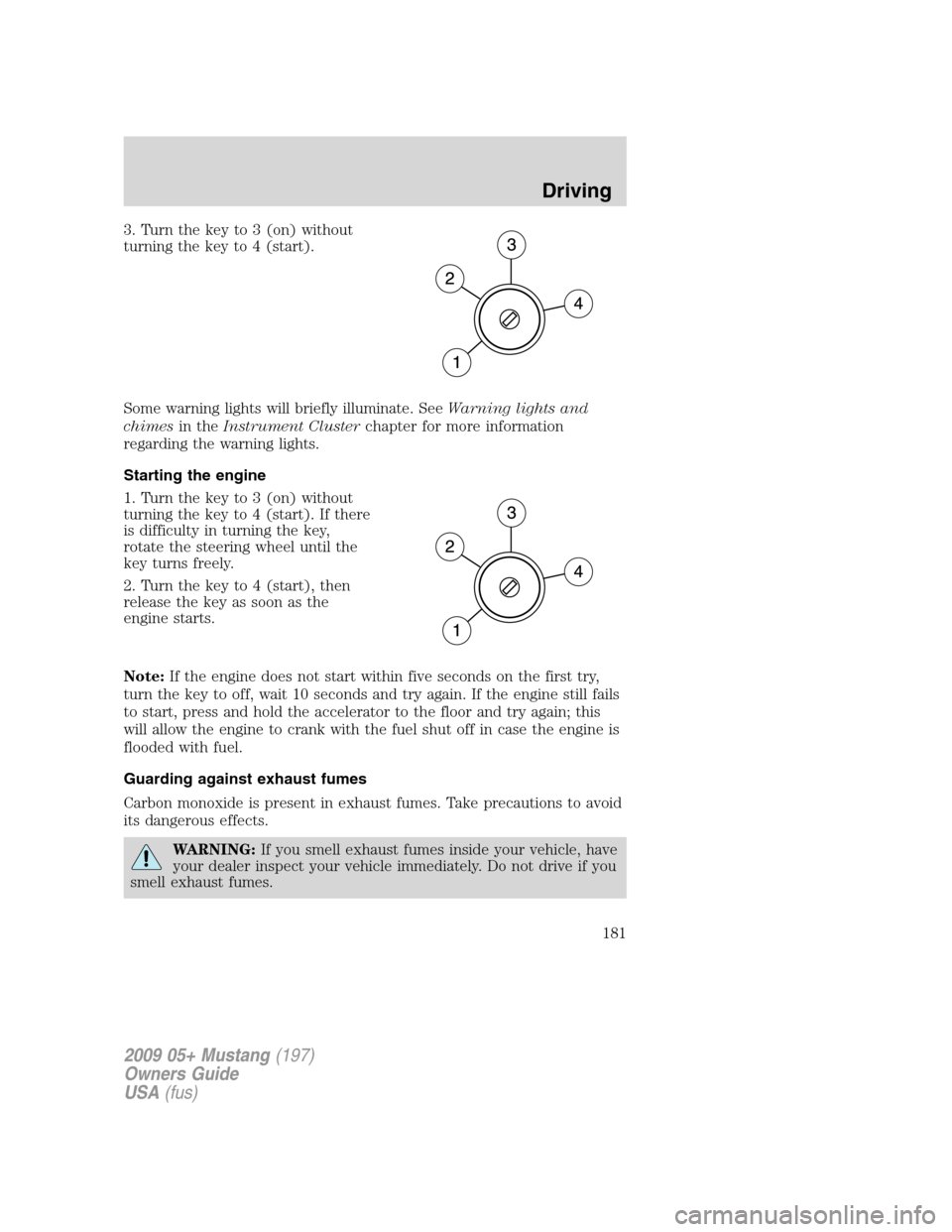
3. Turn the key to 3 (on) without
turning the key to 4 (start).
Some warning lights will briefly illuminate. SeeWarning lights and
chimesin theInstrument Clusterchapter for more information
regarding the warning lights.
Starting the engine
1. Turn the key to 3 (on) without
turning the key to 4 (start). If there
is difficulty in turning the key,
rotate the steering wheel until the
key turns freely.
2. Turn the key to 4 (start), then
release the key as soon as the
engine starts.
Note:If the engine does not start within five seconds on the first try,
turn the key to off, wait 10 seconds and try again. If the engine still fails
to start, press and hold the accelerator to the floor and try again; this
will allow the engine to crank with the fuel shut off in case the engine is
flooded with fuel.
Guarding against exhaust fumes
Carbon monoxide is present in exhaust fumes. Take precautions to avoid
its dangerous effects.
WARNING:If you smell exhaust fumes inside your vehicle, have
your dealer inspect your vehicle immediately. Do not drive if you
smell exhaust fumes.
2009 05+ Mustang(197)
Owners Guide
USA(fus)
Driving
181
Page 184 of 292
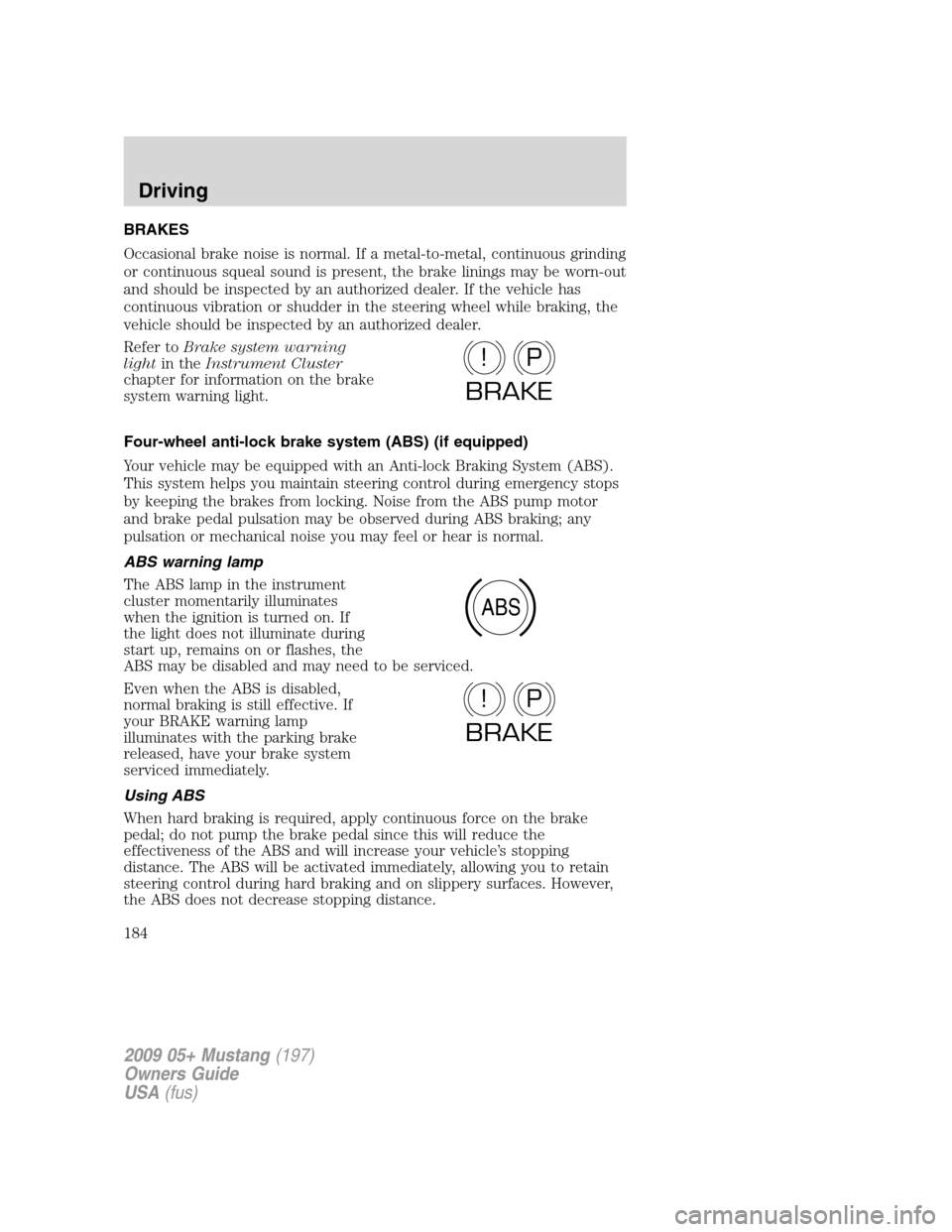
BRAKES
Occasional brake noise is normal. If a metal-to-metal, continuous grinding
or continuous squeal sound is present, the brake linings may be worn-out
and should be inspected by an authorized dealer. If the vehicle has
continuous vibration or shudder in the steering wheel while braking, the
vehicle should be inspected by an authorized dealer.
Refer toBrake system warning
lightin theInstrument Cluster
chapter for information on the brake
system warning light.
Four-wheel anti-lock brake system (ABS) (if equipped)
Your vehicle may be equipped with an Anti-lock Braking System (ABS).
This system helps you maintain steering control during emergency stops
by keeping the brakes from locking. Noise from the ABS pump motor
and brake pedal pulsation may be observed during ABS braking; any
pulsation or mechanical noise you may feel or hear is normal.
ABS warning lamp
The ABS lamp in the instrument
cluster momentarily illuminates
when the ignition is turned on. If
the light does not illuminate during
start up, remains on or flashes, the
ABS may be disabled and may need to be serviced.
Even when the ABS is disabled,
normal braking is still effective. If
your BRAKE warning lamp
illuminates with the parking brake
released, have your brake system
serviced immediately.
Using ABS
When hard braking is required, apply continuous force on the brake
pedal; do not pump the brake pedal since this will reduce the
effectiveness of the ABS and will increase your vehicle’s stopping
distance. The ABS will be activated immediately, allowing you to retain
steering control during hard braking and on slippery surfaces. However,
the ABS does not decrease stopping distance.
P!
BRAKE
ABS
P!
BRAKE
2009 05+ Mustang(197)
Owners Guide
USA(fus)
Driving
184
Page 200 of 292
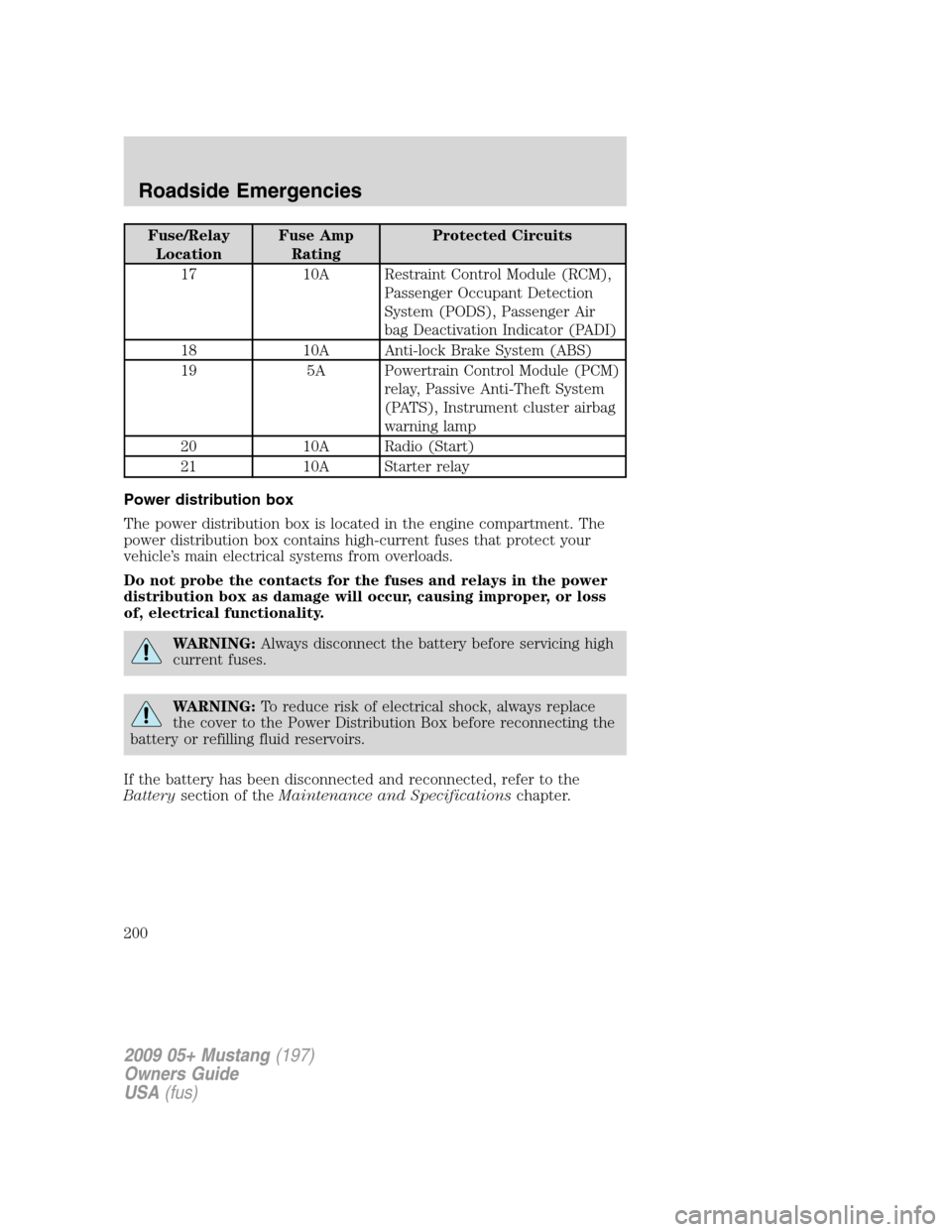
Fuse/Relay
LocationFuse Amp
RatingProtected Circuits
17 10A Restraint Control Module (RCM),
Passenger Occupant Detection
System (PODS), Passenger Air
bag Deactivation Indicator (PADI)
18 10A Anti-lock Brake System (ABS)
19 5A Powertrain Control Module (PCM)
relay, Passive Anti-Theft System
(PATS), Instrument cluster airbag
warning lamp
20 10A Radio (Start)
21 10A Starter relay
Power distribution box
The power distribution box is located in the engine compartment. The
power distribution box contains high-current fuses that protect your
vehicle’s main electrical systems from overloads.
Do not probe the contacts for the fuses and relays in the power
distribution box as damage will occur, causing improper, or loss
of, electrical functionality.
WARNING:Always disconnect the battery before servicing high
current fuses.
WARNING:To reduce risk of electrical shock, always replace
the cover to the Power Distribution Box before reconnecting the
battery or refilling fluid reservoirs.
If the battery has been disconnected and reconnected, refer to the
Batterysection of theMaintenance and Specificationschapter.
2009 05+ Mustang(197)
Owners Guide
USA(fus)
Roadside Emergencies
200
Page 240 of 292
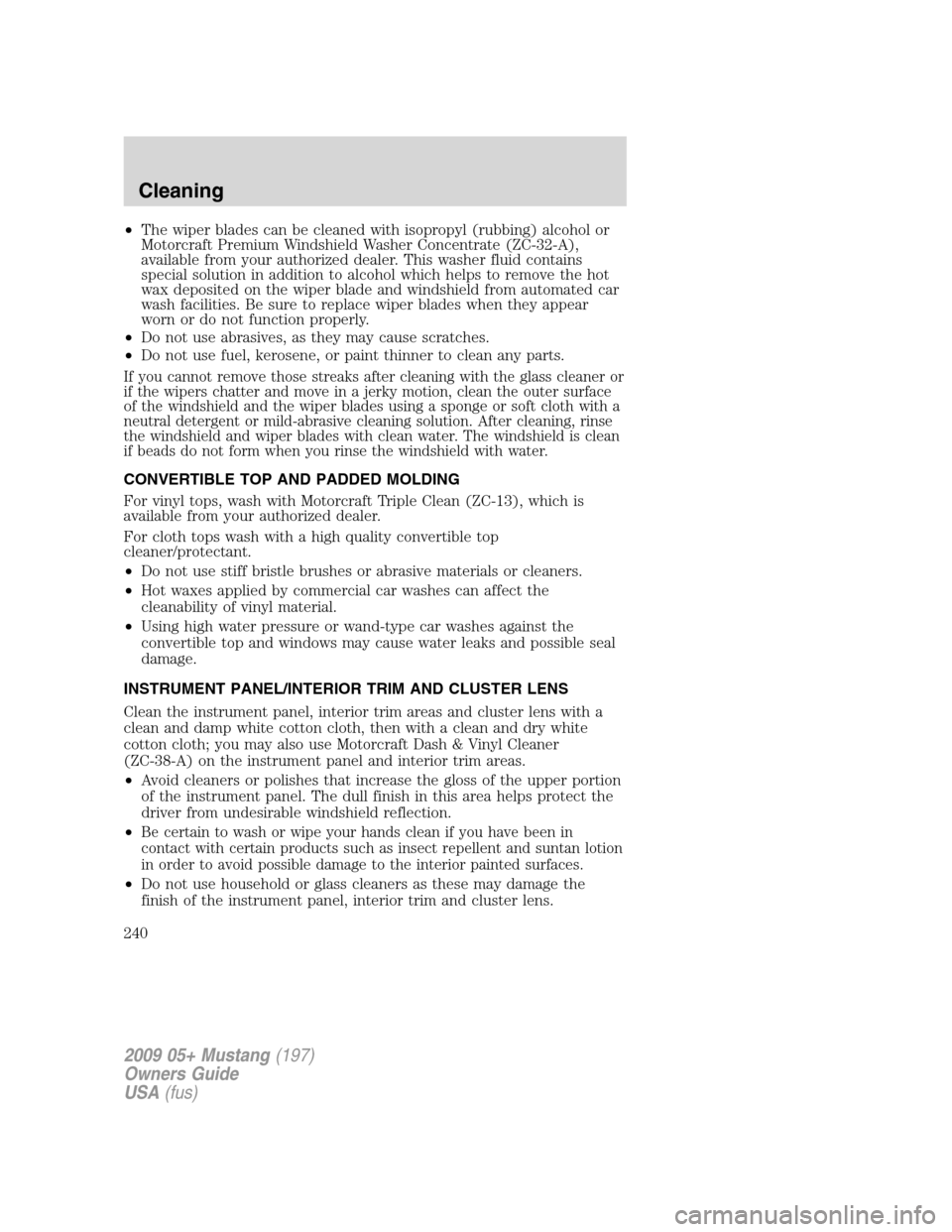
•The wiper blades can be cleaned with isopropyl (rubbing) alcohol or
Motorcraft Premium Windshield Washer Concentrate (ZC-32-A),
available from your authorized dealer. This washer fluid contains
special solution in addition to alcohol which helps to remove the hot
wax deposited on the wiper blade and windshield from automated car
wash facilities. Be sure to replace wiper blades when they appear
worn or do not function properly.
•Do not use abrasives, as they may cause scratches.
•Do not use fuel, kerosene, or paint thinner to clean any parts.
If you cannot remove those streaks after cleaning with the glass cleaner or
if the wipers chatter and move in a jerky motion, clean the outer surface
of the windshield and the wiper blades using a sponge or soft cloth with a
neutral detergent or mild-abrasive cleaning solution. After cleaning, rinse
the windshield and wiper blades with clean water. The windshield is clean
if beads do not form when you rinse the windshield with water.
CONVERTIBLE TOP AND PADDED MOLDING
For vinyl tops, wash with Motorcraft Triple Clean (ZC-13), which is
available from your authorized dealer.
For cloth tops wash with a high quality convertible top
cleaner/protectant.
•Do not use stiff bristle brushes or abrasive materials or cleaners.
•Hot waxes applied by commercial car washes can affect the
cleanability of vinyl material.
•Using high water pressure or wand-type car washes against the
convertible top and windows may cause water leaks and possible seal
damage.
INSTRUMENT PANEL/INTERIOR TRIM AND CLUSTER LENS
Clean the instrument panel, interior trim areas and cluster lens with a
clean and damp white cotton cloth, then with a clean and dry white
cotton cloth; you may also use Motorcraft Dash & Vinyl Cleaner
(ZC-38-A) on the instrument panel and interior trim areas.
•Avoid cleaners or polishes that increase the gloss of the upper portion
of the instrument panel. The dull finish in this area helps protect the
driver from undesirable windshield reflection.
•
Be certain to wash or wipe your hands clean if you have been in
contact with certain products such as insect repellent and suntan lotion
in order to avoid possible damage to the interior painted surfaces.
•Do not use household or glass cleaners as these may damage the
finish of the instrument panel, interior trim and cluster lens.
2009 05+ Mustang(197)
Owners Guide
USA(fus)
Cleaning
240
Page 267 of 292
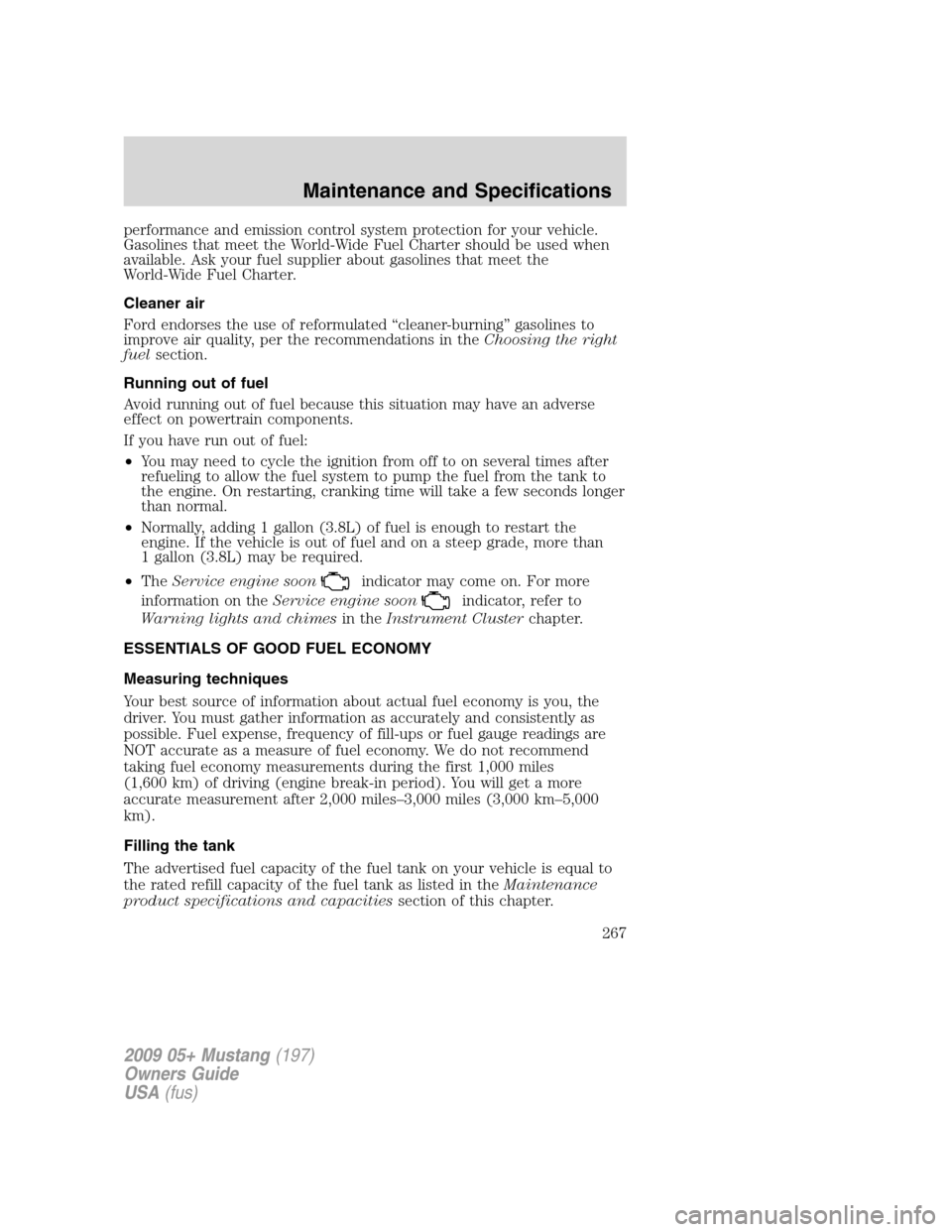
performance and emission control system protection for your vehicle.
Gasolines that meet the World-Wide Fuel Charter should be used when
available. Ask your fuel supplier about gasolines that meet the
World-Wide Fuel Charter.
Cleaner air
Ford endorses the use of reformulated “cleaner-burning” gasolines to
improve air quality, per the recommendations in theChoosing the right
fuelsection.
Running out of fuel
Avoid running out of fuel because this situation may have an adverse
effect on powertrain components.
If you have run out of fuel:
•You may need to cycle the ignition from off to on several times after
refueling to allow the fuel system to pump the fuel from the tank to
the engine. On restarting, cranking time will take a few seconds longer
than normal.
•Normally, adding 1 gallon (3.8L) of fuel is enough to restart the
engine. If the vehicle is out of fuel and on a steep grade, more than
1 gallon (3.8L) may be required.
•TheService engine soon
indicator may come on. For more
information on theService engine soon
indicator, refer to
Warning lights and chimesin theInstrument Clusterchapter.
ESSENTIALS OF GOOD FUEL ECONOMY
Measuring techniques
Your best source of information about actual fuel economy is you, the
driver. You must gather information as accurately and consistently as
possible. Fuel expense, frequency of fill-ups or fuel gauge readings are
NOT accurate as a measure of fuel economy. We do not recommend
taking fuel economy measurements during the first 1,000 miles
(1,600 km) of driving (engine break-in period). You will get a more
accurate measurement after 2,000 miles–3,000 miles (3,000 km–5,000
km).
Filling the tank
The advertised fuel capacity of the fuel tank on your vehicle is equal to
the rated refill capacity of the fuel tank as listed in theMaintenance
product specifications and capacitiessection of this chapter.
2009 05+ Mustang(197)
Owners Guide
USA(fus)
Maintenance and Specifications
267
Page 289 of 292
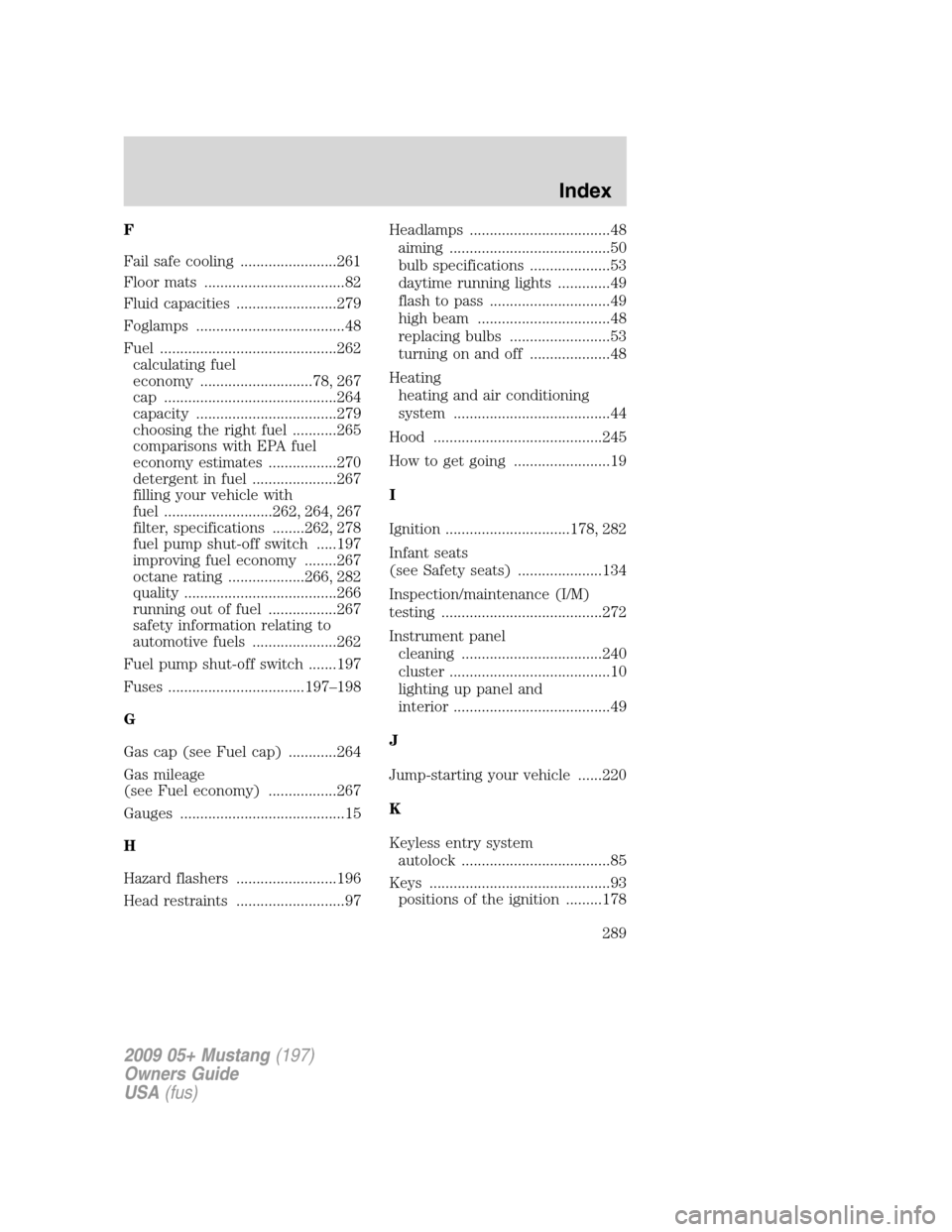
F
Fail safe cooling ........................261
Floor mats ...................................82
Fluid capacities .........................279
Foglamps .....................................48
Fuel ............................................262
calculating fuel
economy ............................78, 267
cap ...........................................264
capacity ...................................279
choosing the right fuel ...........265
comparisons with EPA fuel
economy estimates .................270
detergent in fuel .....................267
filling your vehicle with
fuel ...........................262, 264, 267
filter, specifications ........262, 278
fuel pump shut-off switch .....197
improving fuel economy ........267
octane rating ...................266, 282
quality ......................................266
running out of fuel .................267
safety information relating to
automotive fuels .....................262
Fuel pump shut-off switch .......197
Fuses ..................................197–198
G
Gas cap (see Fuel cap) ............264
Gas mileage
(see Fuel economy) .................267
Gauges .........................................15
H
Hazard flashers .........................196
Head restraints ...........................97Headlamps ...................................48
aiming ........................................50
bulb specifications ....................53
daytime running lights .............49
flash to pass ..............................49
high beam .................................48
replacing bulbs .........................53
turning on and off ....................48
Heating
heating and air conditioning
system .......................................44
Hood ..........................................245
How to get going ........................19
I
Ignition ...............................178, 282
Infant seats
(see Safety seats) .....................134
Inspection/maintenance (I/M)
testing ........................................272
Instrument panel
cleaning ...................................240
cluster ........................................10
lighting up panel and
interior .......................................49
J
Jump-starting your vehicle ......220
K
Keyless entry system
autolock .....................................85
Keys .............................................93
positions of the ignition .........178
2009 05+ Mustang(197)
Owners Guide
USA(fus)
Index
289